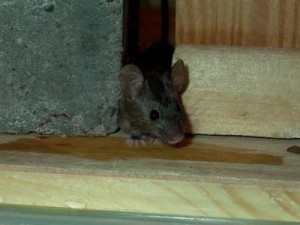Minneapolis MN Wild Animal Removal | Mice & Rodent Removal
If you’ve seen one small, scampering critter, there’s a good chance that the little guy has skittered out of sight by now. If so, your immediate problem — removing a mouse or rodent from your line of sight — no longer exists. Right? You might want to reconsider. That’s because it’s a fairly safe bet that if there’s one sneaky four-legged, whiskered little mouse or rodent spotted sharing your Minnesota home, there are most likely many more generations that are comfortably nestled in your attic insulation, between the walls in your kitchen, in the garage, and hidden in the basement or elsewhere.
A family of 6 mice can multiply into a family of 60 mice in 3 months. Reaching sexual maturity at about four weeks of age, it’s easy to understand how a mouse population within a home can quickly grow out-of-hand. Not to mention the fact that they breed year-round. The staggering birth rate is kept under control naturally by predators in the outdoors, but owls, hawks, cats and other hunters are absent from the typical attic or basement.
The sole natural factor limiting the mouse population in the home is the limitation of resources such as food. As the average house mouse lives for a year, that means a staggering number of mice can become a varmint’s dream house over the course of 365 days. (That’s why there’s no such thing as only one mouse.)
- A single female produces between 5-10 litters annually.
- Each litter consist of 5-6 young that are able to reproduce at approximately 30 days of age.
- Mice produce a great number of young, but have a high mortality rate.
- Mice are an important source of food for wildlife such as hawks, owls, and fox which can control populations outdoors.
- The lifespan of a house mouse is approximately 1 year.
These unwanted invaders can cause major damage in relatively little time by chewing through electrical wiring, nesting in your furniture and walls, vents and attics, filing their teeth on woodwork, and helping themselves to previously opened food containers. Pretty much any food that isn’t securely stored is sure to be added to their menu.
Mice can also spread diseases like salmonella and hantavirus when they contaminate food. Leaving prolific deposits of droppings behind is another down side to these roommates. What is worse is the fact that if you leave these pests alone, they will multiply causing increased damage and costing you even more money.
They’re not the only ones trying to invade your home. Squirrels, raccoons and bats are the most common fur-covered pests that invade our homes (often when the weather starts turning cool) through windows, chimneys, and roof vents. While they can seem somewhat scary, most wild animals are harmless. They’re just looking for food, water and shelter. Removal of these factors is the best way to prevent and control mice and rodent problems.
Keep your home from becoming a varmint’s dream house this winter!
No Free Lunch
First, make sure there are no free lunches. Mice and rodents have a very keen sense of smell, and will follow its nose with persistence until the meal is found.
 Eliminating any and all sources of scents that spell “Dine Here” to these critters is what will go the farthest toward keeping them out of your home. That means anything that is considered food for humans or animals and is not in an unopened container, can or bottle.
Eliminating any and all sources of scents that spell “Dine Here” to these critters is what will go the farthest toward keeping them out of your home. That means anything that is considered food for humans or animals and is not in an unopened container, can or bottle.
Same for the squirrel that thinks your attic is a great place to raise a family, or the raccoon that turns your chimney into a condo.
Don’t Provide a Midnight Buffet
Birdseed, pet food and table scraps attract wildlife from miles away. Only put the amount of birdseed in your feeder in the morning that will be completely consumed by dusk.
Don’t leave pet food or unsecured garbage outside overnight. If you have a pet door, close it at night by sliding a template in place to cover the entrance.
Stop Putting Out The Welcome Mat
Loose shingles are the equivalent of a flashing neon “Vacancy” sign for wildlife. When you’re up on the ladder hanging Christmas lights, carefully inspect your roof and eaves.
Repair deteriorating boards, warped siding and damaged shingles. Trim overhanging branches that provide easy access to your roof for squirrels and other wildlife. Cover attic openings with heavy gauge, rustproof wire mesh.
If you have a chimney, make sure that it has a secure cap. Chimneys without caps are open invitations to raccoons looking for “hollow trees” in which to give birth and raise their young. (Don’t worry; chimney caps only deter wildlife, not Santa.)
Poisons are an option for mice, including closed, baited containers with a small opening for the mouse to enter. But we’re not recommending poisons. They’re a danger to kids and pets. Plus, since poison doesn’t work immediately, the dying mouse crawls off somewhere to die and decompose, leaving a smell you will never find, but will always remember.
Don’t Ignore Those Sounds In The Attic
If you’re hearing strange noises from your attic and you suspect that furry guests have already moved in, contact a Minnesota wild animal removal company for a free inspection to determine the best way to humanely evict and permanently exclude them.
They can handle your entire problem from start to finish, starting with removing animals humanely all the way through repairing their damages and preventing it from happening again.



